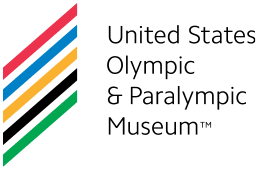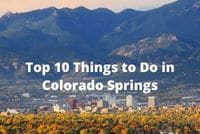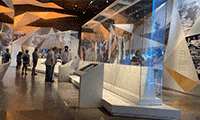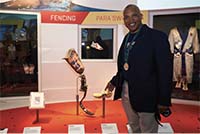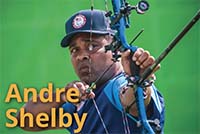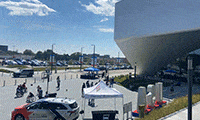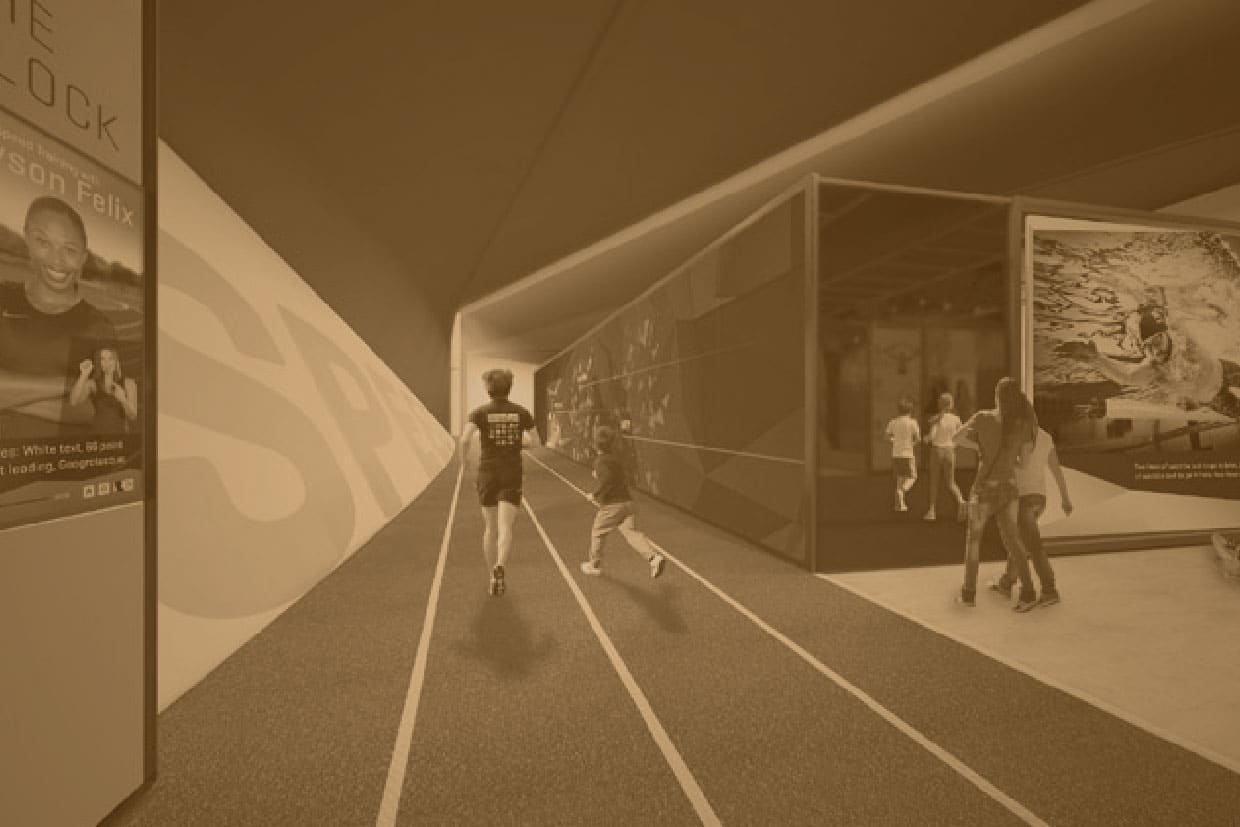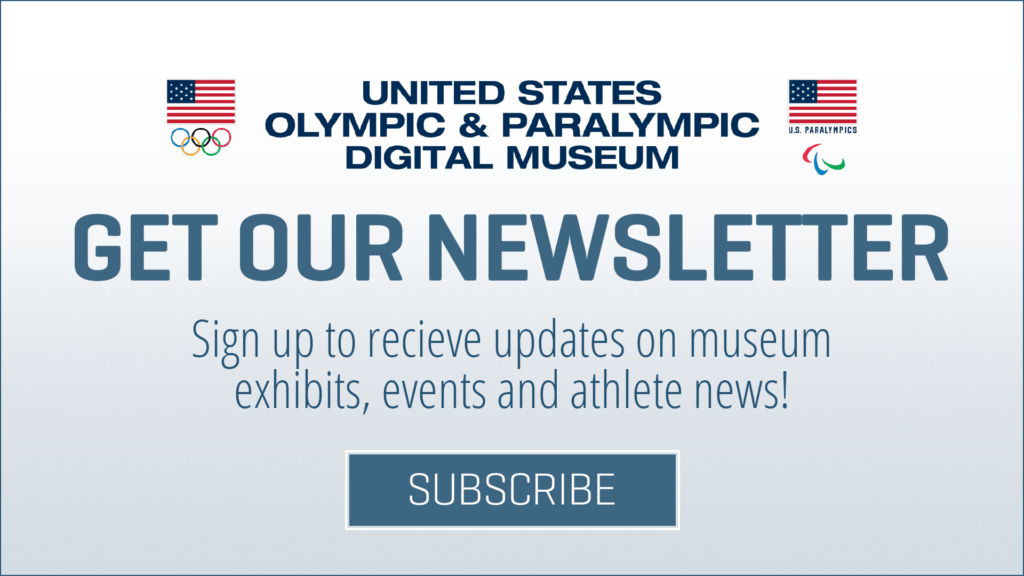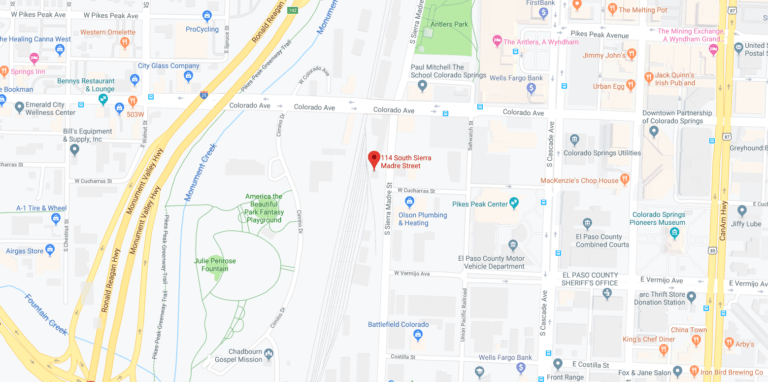This article was originally published on CSIndy.com
Chris Liedel boasts an impressive résumé, having spent 16 years as a National Geographic executive and about six as president of Smithsonian Enterprises, the revenue-producing arm of the Smithsonian Institution.
A year ago, he set a new course by accepting the CEO position for the U.S. Olympic Museum and Hall of Fame in Colorado Springs.
Under construction at Vermijo Avenue and Sierra Madre Street, the $75-million museum is one of five planned City for Champions venues paid for in part with $120.5 million in state sales tax revenue allocated in 2013 through the Regional Tourism Act.
The museum will use $26.2 million in state tax money, with the balance coming from loans issued by local banks, grants and donations.
The other C4C projects include a downtown stadium, an ice hockey arena at Colorado College, a visitors center at the Air Force Academy, and University of Colorado at Colorado Springs’ Hybl Sports Medicine and Performance Center. But none are as far along as the museum.
Located on land donated by an entity controlled by Nor’wood Development Group, the museum rises amid a rundown industrial area flanked by railroad tracks and warehouses. Stakeholders envision it as the chief anchor for a billion-dollar overhaul of the Southwest Downtown Urban Renewal Area, orchestrated by Nor’wood.
As yet, the museum stands as the only tangible evidence of Nor’wood’s ambitious plan, nearly two decades in the making. Even the futuristic museum, rising across the train tracks from America the Beautiful Park, faces some financial uncertainties. While the city contends 262,000 of the museum’s expected 350,000 annual attendees will be net new out-of-state visitors, a Denver consultant hired by the state estimated the number of out-of-state visitors at only 105,000 of the 350,000 yearly total.
Nevertheless, excitement continues to rise in tandem with the angular, stainless steel walls of the project, and Liedel has met with media outlets in recent weeks to give updates on its progress. On April 5, he sat down with the Independent to discuss the museum, slated to open next year.
Designed to encapsulate 100 years of the agony and ecstasy of Olympic sports, the high-tech museum, like the athletes it will honor, has taken years to get into shape.
As Liedel puts it, “This is a marathon as opposed to a sprint.”
Indy: Why did you accept this position? What was attractive about it to you?
Chris Liedel: I wanted to try to do something entrepreneurial. And so I let them [Smithsonian] know I was going to step down and go pursue some other options and I had a blank sheet of paper. I served on the board of the United States Golf Association, and then the PGA [Professional Golfers’ Association].
The gentleman who was running the search for this position ran the search for the PGA for their new president. He was looking for somebody with international experience, museum experience and Olympic sports experience and I sort of had all three, and so I said this was a perfect fit. Then I had the good fortune of coming out and seeing the city and walking around. And I think the community has got a lot going for it and I just felt that it was really ready to step out onto the national scene.
And when I saw not just a museum project, but what the city wants to try to accomplish down in that whole revitalization, I thought, ‘How can I help? How can I serve the community?’ That’s why I wanted to give it a shot.
Where does the museum stand financially, and how is the local fundraising project going?
We’re on track to be able to open next year. We have a plan goal of $88 million. We had a strong fundraising year, but we still have a few million that’s still outstanding that we’re trying to raise. And we have a robust program with the community campaign [announced in January]. The goal is to try to raise $2.5, $3 million from that campaign.
Our goal is to let the community have a chance to be involved. This town has a lot of civic pride, and we want people to be able to walk up and say, “Hey, I helped build this museum,” whether it’s $10, $50, $100, $5,000. We’re about halfway through what we were hoping to accomplish there.
I remember as a young kid, one of my favorite things was going around and raising funds for the March of Dimes. Even though my contribution was maybe small, it allowed me to feel a part of something. So I want to let the community, regardless of their capacity to give, to have that chance.
Do you have an opening date yet?
We’re looking at the spring of next year… Construction is about 80 percent done. We’re just finalizing the design of the exhibits. And it’s one of the reasons why we want to start sharing where we’re going, and then we’re starting to put into place the systems to run the business as an ongoing concern.
Is it your intention to be here after the museum opens for a good long time? Or was your goal to come in and finish the fundraising, open the museum and move on?
Well, I was hoping to be here as long as I can serve the community. And one of the reasons for coming is to be the CEO of the museum as it is ongoing so that I can stay involved in some of the early decisions. You know, it’s always difficult to come in as a CEO after something’s been built.
What’s been your biggest challenge so far?
The biggest challenge has come in making sure that the museum has multi-facets. We want to focus on how the museum can reach different audiences with different backgrounds. And how do we portray the museum as an art museum? How do we do it as a science museum? How do we do it as a history museum, as well as the Olympic sports museum? How do we make sure that as people come through, it has a richness to it so that you want to come back again and again?
What’s your strategy for making this museum a venue that will attract out-of-state visitors?
First, we have what I think are very realistic goals for visitation. Nationally, 70 percent of museum visitors come from out of state. Our goal is to embrace what the community is trying to do and to make sure, programmatically, we are offering aspects that can get people to come for two or three days. We’ll look at some type of programmatic activities in which we can do festivals and things to create ways to tie to the Olympic movement and the various games. The Olympic Museum will be a beacon to the rest of the country in terms of the stories we’re telling.
Part of our approach is to make sure that we focus on this being a museum of hopes and dreams. We want to ignite people to do their best. We want to inspire them, and we want to celebrate those athletes who have done great work. And we want to make sure that it’s a place that all Olympic and Paralympic athletes feel it’s a place where they can come in and be celebrated as a competitor for our country.
We also look at it as part of American history. When you look at the time frame of the modern Olympic movement, it’s covered half of our history as a nation.
The Hall of Fame is going to be a wonderful component. It’ll create a lot of opportunities for us to recognize those competitors for their unique achievement, but also focus on educational programs for school groups and Millennials to partake [in]. So I think we’ll find our footing. Having worked with the Smithsonian and its 20 different museums, I’ve seen a lot of different ways in which you try to create engagement.
As a country, we’re moving into more of an experience economy. People want to have experiences. It’s one of the reasons we have a narrative arc to our museum. We’ll have a beginning, middle and end to our story. But throughout, there’ll be different facets. We’ll talk about the ancient games, the ancient cultures of Greece. We’ll have things on wellness and education. Our sports interactives are being designed for 6-year-olds up to 85-year-olds in the way that you can participate. RFID technology will allow you to set your preferences, so you’ll have almost a personalized experience.
So I like to say every day is going to be opening day because what you see that day will be totally unique.
The USOC has been entangled in a lot of legal problems due to its apparent turning a blind eye to sexual assaults of its athletes. Will the museum incorporate those scandals into its exhibits, and if so, how?
The answer is yes. And we will do it with the right level of thoroughness, but also with the right level of appropriateness. We want to make sure that families coming in understand the subject matter will be covered — that it will be done in a way that I think is highly responsible and to make sure it’s fair and balanced. And it’s not just that issue, but also social progress issues throughout that whole 124-plus years of history that we’ve had with the games. As a museum of this caliber, we have to do that. We won’t shy away from this or other things that may come up.
Are you interfacing with some of the alleged victims themselves?
We will be and we have. That’s a story that we want to get right and do it thoroughly. But also this is a museum that we hope is more timeless in that we will be able to have that story that happened 40 years ago, or 50 years ago. We’ll tell those stories so that they’re timeless but still have that same relevance and build on this advancement and social progress of which this is now a very important part.
What role, if any, is the USOC itself playing in this museum project?
They are a partner. That partnership provides us access to content and to their archive. It’s also providing us access to athletes and the athlete community.
We brought in athletes that were part of the United States Olympic and Paralympic Association who were alumni and competed in Games as far back as the 1960s, as well as athletes who are currently Olympic hopefuls [who are] in, or have just recently competed, in the Games, to talk about the accessibility, the balance of stories. The national governing bodies who have been involved provide us feedback. The USOC helps us with fact-checking, so there’s been a great deal of cooperation.
Has the USOC contributed money?
It has not, and it was not their intent to contribute money.
Will the USOC, in some form, have the final say of approval of all the content in the museum?
They are doing quality control for us to make sure that the stories and the athletes are represented correctly. We’re making sure that the content is proper. They’re not telling us what stories to write or how to write the stories. They’re just wanting to make sure that we have the right information. It gives us an authenticity that we need that the athlete community will be comfortable with.
There’s differences between the way the International Olympic Committee recognize who are Olympic athletes versus the way the USOC does. The 1980 [summer] team is not recognized as Olympic athletes by the IOC, but we recognize them. [The United States boycotted the Moscow Olympic games to protest the Soviet Union’s invasion of Afghanistan.] So those are things that they’re helping us make sure that we have the fine points worked out.
As far as development around the museum, what concerns do you have about that unfolding in a timely way so that we don’t have a world class facility opening with nothing going on around it and inadequate parking?
I’m an optimist with the plan coming into being, but I’m also realistic. We’ve got to be a shining light in what could be $1.5 billion or more investment in that area over the next 10 to 15 years. We want to be a catalyst to help that.
What’s a typical day in the life of Chris Liedel?
I spend a lot of time thinking about where we need to be for opening, in 2020 and in 2022 [Beijing Winter Games]. We know part of our future. We know [the Olympic Games is] going to Tokyo, to Beijing, to Paris, and ultimately, in 10 years, we’re going to L.A. So you start thinking about what do we need to do to plan the transformation of the content? How do we focus and what are the milestones? I spend a lot of my time thinking about where we need to be to have world-class content.
A lot of my time is looking at our partner relationships, making sure of the products that we select for the store, the menu. We want to have a way to do evening events, cultural and arts, and that would include culinary.
As [the Games] move into Japan, what can we [at the museum] do at the restaurant and café for the foodies in town that want to come in and have a unique experience? So it’s a way for us to activate the museum, not just for sports-minded people, but people that would enjoy the sports backdrop.
Any final words about the project?
It really is a community museum. I’m looking to make sure that we’re [doing] what we can do with the Fine Arts Center, with the Ent Center, with the Pioneers Museum, and working together to create a set of experiences that really resonate for our people that live here, as well as those who would be attracted to come and visit.
How can we be a flagship, not just with the Olympic Museum, but as a cultural institution in town? And that’s what we hope. We want to be a good citizen of the community.
